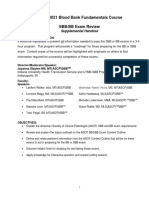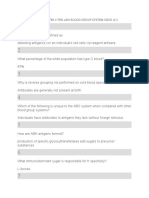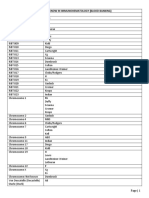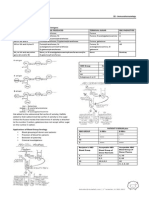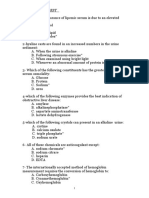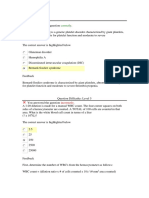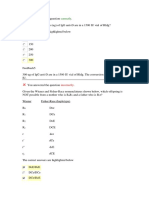Blood Bank Guy Blood Groups
Blood Bank Guy Blood Groups
Uploaded by
Jessica TuCopyright:
Available Formats
Blood Bank Guy Blood Groups
Blood Bank Guy Blood Groups
Uploaded by
Jessica TuOriginal Description:
Copyright
Available Formats
Share this document
Did you find this document useful?
Is this content inappropriate?
Copyright:
Available Formats
Blood Bank Guy Blood Groups
Blood Bank Guy Blood Groups
Uploaded by
Jessica TuCopyright:
Available Formats
The Osler Institute
Blood Bank I
D. Joe Chaffin, MD
Bonfils Blood Center, Denver, CO
The Fun Just Never Ends
A. Blood Bank I
Blood Groups
B. Blood Bank II
Blood Donation and Autologous Blood
Pretransfusion Testing
C. Blood Bank III
Component Therapy
D. Blood Bank IV
Transfusion Complications
* Noninfectious (Transfusion Reactions)
* Infectious (Transfusion-transmitted Diseases)
E. Blood Bank V (not discussed today but available
at www.bbguy.org)
Hematopoietic Progenitor Cell Transplantation
F. Blood Bank Practical
Management of specific clinical situations
Calculations, Antibody ID and no-pressure sample
questions
Blood Bank I
Blood Groups
I. Basic Antigen-Antibody Testing
A. Basic Red Cell-Antibody Interactions
1. Agglutination
a. Clumping of red cells due to antibody coating
b. Main reaction we look for in Blood Banking
c. Two stages:
1) Coating of cells (sensitization)
a) Affected by antibody specificity, electrostatic
RBC charge, temperature, amounts of antigen
and antibody
b) Low Ionic Strength Saline (LISS) decreases
repulsive charges between RBCs; tends to
enhance cold antibodies and autoantibodies
c) Polyethylene glycol (PEG) excludes H2O, tends
to enhance warm antibodies and autoantibodies.
2) Formation of bridges
a) Lattice structure formed by antibodies and RBCs
b) IgG isnt good at this; one antibody arm must
attach to one cell and other arm to the other cell.
c) IgM is better because of its pentameric structure.
P}Chaffin (12/28/11)
Blood Bank I
page 1
Pathology Review Course
2. Hemolysis
a. Direct lysis of a red cell due to antibody coating
b. Uncommon, but equal to agglutination.
1) Requires complement fixation
2) IgM antibodies do this better than IgG.
B. Tube testing
1. Immediate spin phase
a. Mix serum, 2-5% RBC suspension; spin 15-30 sec.
1) Most common: 2 drops serum, 1 drop RBCs.
b. Antibodies reacting here are usually IgM
2. 37 C phase
a. Add potentiator (+/-), incubate at 37 C, spin.
b. Potentiators and incubation times:
1) 10-15 minutes for LISS
2) 15-30 minutes for albumin or PEG
3) 30-60 minutes for no potentiation
3. Indirect antiglobulin (antihuman globulin) phase
a. Wash above to remove unbound globulins.
b. Add antihuman globulin, spin.
C. Alternatives to tube testing
1. Column agglutination technology (Gel testing)
a. Add RBCs and plasma to top of tube, incubate, spin.
b. Microtubes are filled with gel particles and anti-IgG
1) Anti-IgG grabs onto IgG-coated RBCs and inhibits
their migration through gel immunologically
2) Gel particles separate RBC clusters physically
(inhibit agglutinates from migrating through gel).
c. Results:
1) Negative: RBCs form button at bottom of
microtube.
2) Positive: RBCs stopped in areas through the
microtube (more positive = higher position in tube)
d. Can be automated (ProVue machine)
e. Similar sensitivity to PEG tube testing
2. Solid-phase Red Cell Adherence Testing
a. Antibody binds to lysed or intact RBC antigens that
are bound by manufacturer to the sides of microwells
b. Add patient serum, incubate, wash: If positive,
antibody binds to test RBCs.
c. Indicator RBCs (coated with monoclonal anti-IgG)
attach to antibody on test RBCs.
d. Spin and interpret
1) Negative: RBCs in a button at bottom of microwell,
(indicator cells didnt bind to the test RBCs).
2) Positive: RBCs spread in a carpet all along the
microwell (indicator cells did bind to test RBCs).
e. Can be automated (Galileo, Galileo Echo, NEO)
f. Similar sensitivity to PEG tube testing
page 2
Blood Bank I
P}Chaffin (12/28/11)
The Osler Institute
D. The Antiglobulin Test (Coombs Test)
1. Indirect: see above; demonstrates in-vitro RBC coating
with antibody and/or complement.
2. Direct: red cells from patient washed, then mixed with
antihuman globulin; demonstrates in-vivo RBC coating
with antibody and/or complement.
3. IAT variations
a. Unknown antibody check: Use RBCs with a known
antigen profile, as in an antibody screen
b. Unknown RBC antigen check: Use serum with known
antibody specificity, as in RBC antigen testing
c. Can be used to check for an unknown antigen OR
unknown antibody, as in the crossmatch procedure
4. Specificity possibilities for the antiglobulin
a. Anti-IgG, -C3d (polyspecific); most common to start
1) Detect red cells coated with either of the above
2) May also detect other immunoglobulins (because
the anti-IgG detects light chains, too)
b. Anti-IgG and anti-IgG (heavy chain-specific)
1) Both detect IgG-coated red cells
2) Anti-IgG used for PEG, gel, and solid phase tests
c. Anti-C3b, -C3d
1) Detects either of the above complement components
2) Most useful in evaluating IgM-related hemolysis,
cold agglutinin disease
5. IgG-sensitized RBCs (Coombs control, check cells)
a. Use after negative DAT or IAT tube test (not gel or
solid-phase) to ensure functioning of AHG reagent
b. Add IgG-coated cells to AHG-cell mixture
c. Negative = bad AHG or no AHG added
d. Other errors (e.g., omitting test serum) missed.
E. Dosage
1. Some antibodies react more strongly with RBC antigens
that have homozygous gene expression.
2. For example, imagine a hypothetical anti-Z
a. Patient 1 genotype: ZZ (Homozygous for Z)
b. Patient 2 genotype: ZY (Heterozygous for Z)
P}Chaffin (12/28/11)
Blood Bank I
page 3
Pathology Review Course
c. If anti-Z shows dosage, it will react stronger with
patient 1s RBCs (see below).
RBC Genotype
Reaction with anti-Z
ZZ
3+
ZY
1+
3. Most common in Kidd, Duffy, Rh and MNS systems
F. Enzymes
1. Proteolytic enzymes (e.g., ficin, papain) cleave RBC
surface glycoproteins and can strengthen reactions by
enhancing antigen expression or allowing antibodies to
bind better to previously shielded antigens
2. Enzymes may also directly destroy other antigens
3. Useful in antibody identification to confirm or refute a
particular antigen as target of an antibody (see table)
4. The Enzyme Classification
Enhanced
ABO-related
ABO, H Systems
Lewis System
I System
P System
Rh System
Kidd System
Decreased
MNS System
Duffy System
Lutheran System
Unaffected
Kell System
Diego System
Colton System
G. Neutralization
1. Certain substances, when mixed with a red cell antibody,
inhibit the activity of that antibody against test red cells.
2. Some of these are pretty weird! (See table below)
Neutralization of Antibodies
ABO
Lewis
Sda
Saliva (secretor)
Saliva (secretor for Leb)
Hydatid cyst fluid
Pigeon egg whites
Human urine
Chido, Rodgers
Serum
P1
H. Lectins
1. Seed/plant extracts react with certain RBC antigens
2. Especially useful in polyagglutination (T, Tn, etc)
3. May be commercial or homemade
page 4
Lectin
Specificity
Dolichos biflorus
Ulex europaeus
Vicia graminea
Arachis hypogea
Glycine max
Salvia
A1
H
N
T
T, Tn
Tn
Blood Bank I
P}Chaffin (12/28/11)
The Osler Institute
II. Blood Groups
A. General characteristics
1. Definition
a. Blood group antigen: Protein, glycoprotein, or
glycolipid on RBCs, detected by an alloantibody
1) NOTE: Antigens are not limited to RBCs
b. Blood group system: Group of blood group antigens
that are genetically linked (30 total systems per ISBT)
2. Significance
a. Significant = antibody causes HTRs or HDFN
b. Most significant antibodies are warm reactive;
meaning they react best at IAT (37 C).
c. Most insignificant antibodies are cold reactive;
meaning they react best below 37 C.
d. Warm antibodies most often IgG, colds usually IgM.
e. IgM antibodies are usually naturally occurring (no
transfusion or pregnancy required for their formation).
f. ABO is the exception; see asterisks in table below
WARM-REACTIVE
IgG
Require exposure
Cause HDN
Cause HTRs
Significant
COLD-REACTIVE
IgM
Naturally occurring
No HDN*
No HTRs*
Insignificant*
B. ABO and H Systems
1. Basic biochemistry (see figure below)
a. Type 1 and 2 chains
1) Type 1: Glycoproteins and glycolipids in secretions
and plasma carrying free-floating antigens
2) Type 2: Glycolipids and glycoproteins carrying
bound antigens on RBCs.
b. Se gene (FUT2; FUT = fucosyltransferase)
1) Secretor gene (chrom 19); Precursor to making A
or B antigens in secretions
2) FUT enzyme adds fucose to type 1 chains at
terminal galactose; product is type 1 H antigen
3) 80% gene frequency
c. H gene (FUT1)
1) Closely linked to Se on chrom 19
2) FUT enzyme adds fucose to type 2 chains at
terminal galactose; product is type 2 H antigen.
3) Virtually 100% gene frequency (Bombay = hh).
d. H antigen required before A and/or B can be made on
RBCs (type 2 H) or in secretions (type 1 H).
1) Single sugar added to a type 1 or 2 H antigen chain
makes A or B antigens and eliminates H antigen.
a) Group A sugar: N-acetylgalactosamine
P}Chaffin (12/28/11)
Blood Bank I
page 5
Pathology Review Course
b) Group B sugar: Galactose
2) As more A or B is made, less H remains.
a) H amount: O > A2 > B > A2B > A1 > A1B
2. ABO antigens
a. Genotype determined by three genes on long arm of
chrom 9: A, B and O (O is nonfunctional).
b. A and B genes code for transferase enzymes, not
directly for an antigen (as above)
c. ABO antigens begin to appear on fetal RBCs at 6
weeks gestation; reach adult levels by age 4.
1) Also present on platelets, endothelium, kidney,
heart, lung, bowel, pancreas tissue
3. ABO antibodies
a. Antibodies clinically significant, naturally occurring
b. Begin to appear at 4 months of age; reach adult levels
by age 10 and may fade with advanced age
f. Three antibodies: anti-A, anti-B and anti-A,B; differ
by blood group
1) Group A and B: Anti-A or B is predominantly
IgM, but each reacts strongly at body temperatures.
2) Group O: Anti-A and B are predominantly IgG,
and react best at body temperatures
3) Group O: Anti-A,B is IgG reacting against A and/or
B cells (reactivity cant be separated into individual
specificities).
Type
Whites
Blacks Asians Native Americans
O
45%
49%
40%
79%
A
40%
27%
28%
16%
B
11%
20%
27%
4%
AB
4%
4%
5%
<1%
4. ABO blood groups
a. Group O
1) The most common blood group across racial lines
2) Genotype: OO
3) Antigen: H
a) Ulex europaeus lectin reacts with H antigen.
page 6
Blood Bank I
P}Chaffin (12/28/11)
The Osler Institute
4) Antibodies: Anti-A, anti-B, anti-A,B (see above)
a) Because of strong IgG component to all above
antibodies, mild HDFN is common in O moms
b) Why not severe? Weak fetal ABH expression,
soluble ABH antigens (neutralize antibodies)
b. Group A
1) Possible genotypes: AA, AO
2) Antigens: A, H
3) Antibody: anti-B (primarily IgM).
4) A subgroups
a) A1 (80%) and A2 (~20%) most important
b) Monoclonal anti-A agglutinates both types well
c) A1 red cells carry about 5x more A on RBC
surfaces than A2 cells
d) Qualitative differences also exist in the structure
of the antigenic chains (type 3 and 4 for A2).
e) 1-8% of A2 and 25% of A2B form anti-A1.
Usually clinically insignificant IgM
Common cause of ABO discrepancies.
If reactive at 37C, avoid A1 RBC transfusion.
f) Dolichos biflorus lectin agglutinates A1 but not
A2 RBCs.
c. Group B
1) Genotypes: BB, BO
2) Antigens: B, H
3) Antibodies: Anti-A (primarily IgM).
4) B subgroups: Usually unimportant and less frequent
d. Group AB
1) Least frequent ABO blood type (about 4%)
2) Antigens: A and B (very little H)
a) Can be further subdivided into A1B or A2B
depending on the status of the A antigen
3) Antibodies: none
5. ABO testing
Cell
Anti-A Anti-B
Serum
A1 cells B cells
4+
4+
4+
4+
4+
4+
4+
4+
ABO
Group
A
B
AB
O
a. Cell grouping (forward grouping)
1) Patient red cells agglutinated by anti-A, anti-B.
b. Serum grouping (reverse grouping, back typing)
1) Patient serum (or plasma) against A1 and B RBCs.
c. Note the opposite reactions!
1) If forward reactions are not opposite of reverse, an
ABO discrepancy is present.
P}Chaffin (12/28/11)
Blood Bank I
page 7
Pathology Review Course
d. Both serum and cell grouping required unless testing
babies < 4 months of age or reconfirming ABO testing
done on donor blood (requires cell grouping only).
6. ABO discrepancies
a. Disagreement between the interpretations of cell and
serum grouping (e.g., forward = A, reverse = O);
caused by antigen and/or antibody problems or
technical errors.
b. Antigen problems
1) Missing antigens
a) A or B subgroups
b) Transfusion or transplantation
c) Leukemia or other malignancies
2) Unexpected antigens
a) Transfusion/transplantation out-of-group
b) Acquired B phenotype (more below)
c) Recent marrow/stem cell transplant.
d) Polyagglutination
c. Antibody problems
1) Missing antibodies
a) Immunodeficiency
b) Neonates, elderly, or immunocompromised
c) Transplantation or transfusion
d) ABO subgroups
2) Unexpected antibodies
a) Cold antibodies (auto- or allo-)
b) Anti-A1
c) Rouleaux/plasma expanders (false positive)
d) Transfusion or transplantation
e) Reagent-related antibodies
d. Technical errors
1) Sample/reagent prep, mix-ups, or interpretation
errors
7. Weird stuff about ABO
a. Acquired B phenotype
1) A1 RBC contact with enteric gram negatives: Colon
cancer, intestinal obstruction, gram-negative sepsis
2) AB forward (with weak anti-B reactions), A reverse
3) Bacterial enzymes deacetylate group A GalNAc;
remaining galactosamine looks like B and reacts
with forms of monoclonal anti-B (ES-4 clone).
Cell Typing
Serum Typing
AntiA
AntiB
Interp
A1
cells
B
cells
Interp
4+
1-2+
AB
4+
4) Use monoclonal anti-B that does NOT recognize
acquired B, acidify serum (no reaction with anti-B)
page 8
Blood Bank I
P}Chaffin (12/28/11)
The Osler Institute
b. B(A) phenotype
1) Opposite of acquired B (group B patients with weak
A activity); this condition is inherited, not acquired
2) Cross-reaction with a specific monoclonal anti-A;
test using different anti-A shows the patient as B.
c. Bombay (Oh) phenotype
1) Total lack of H, A and B antigens due to lack of H
and Se genes (genotype: hh, sese)
2) Naturally occurring strong anti-H, anti-A, anti-B
3) Testing: O forward, O reverse, but antibody screen
wildly positive and all units incompatible
4) Para-Bombay phenotype
a) Like Bombays, are hh, but unlike Bombays,
have at least one Se gene
b) Phenotypes: Ah, Bh, ABh
c) RBCs may be Bombay-like, but may also show
free or RBC A or B antigens (unless group O).
d) Allo-anti-H present in serum.
5) Both Bombay and Para-Bombay need H-negative
blood (from Bombay donors)
8. Consequences of ABO incompatibility
a. Severe acute hemolytic transfusion reactions
1) Among most common blood bank fatalities
2) Clerical errors
b. Most frequent HDFN; usually mild, however
C. Lewis System
1. Biochemistry (see figure below)
a. Type 1 chains only
b. One gene: Le (FUT3)
1) Second gene, le, is nonfunctional
c. FUT enzyme adds fucose to subterminal GlcNAc
(left side of figure below).
1) This makes Lea (Lewis A) antigen.
2) Lea antigens cannot be modified to make Leb.
d. In secretors, Se product (FUT2) adds fucose, then Le
product adds fucose; this makes Leb (Lewis B).
1) In secretors, Leb formation occurs preferentially.
P}Chaffin (12/28/11)
Blood Bank I
page 9
Pathology Review Course
2) As a result, the vast majority of the chains of those
who carry Le and Se are Leb rather than Lea.
3) In non-secretors, Lea is only possible Lewis antigen.
e. Unlike ABO, antigens are not tightly bound
(remember, they are made from type 1 chains); rather,
they adsorb onto the surface of RBCs.
1) Leb does this better than Lea; another reason that
most adults with both Le and Se will be Le(a-b+).
2) Le(a-b+) people still have Lea, just in much smaller
quantities that may not show up on RBCs.
f. Same chain can carry Le and ABO antigens (unlike the
inverse relationship with ABO and H).
2. Lewis phenotypes, antigens, and antibodies
a. Phenotypes: Le(a-b+), Le(a+b-), Le(a-b-)
b. 22% of blacks are Le(a-b-), vs. only 6% of whites.
c. Antibodies are naturally occurring, cold-reacting IgM.
1) Primarily in Le(a-b-)
2) Neutralize with saliva from secretors.
3) Antibodies commonly also show ABH specificity
(e.g., anti-LebH reacts best with O or A2 RBCs)
3. Consequences of incompatibility
a. Antibodies are generally insignificant
b. Rare HTRs (more commonly with anti-Lea)
c. No HDFN (antibody doesnt cross placenta and Le
antigens are not present on fetal RBCs).
4. Weird stuff about Lewis
a. Lewis antigens decrease during pregnancy.
1) Pregnant patients may appear Le(a-b-) and have
transient, insignificant Lewis antibodies.
2) Increased plasma volume dilutes the antigens and
increased plasma lipoproteins strip the antigens
b. Le(a-b+) people dont make anti-Lea.
1) Still have Lea, just not visible on their RBCs.
c. Childrens Lewis type may vary, as antigen chains are
converted [more Lea than Leb initially, with a transient
period of Le(a+b+)]; by age 2, are Le(a-b+)
d. Infection associations:
1) H. pylori attaches to gastric mucosa via Leb antigen.
2) Norwalk virus also attaches via Leb
3) Le(a-b-) are at risk for Candida and E. coli infection
D. I System
1. Antigens built on type 2 chains.
2. Expression is age-dependent.
a. Simple chains found on neonates make i antigen.
b. Branched chains in adults make I antigen.
c. Big I in big people, little i in little people
d. Occasional adults lack I; they are known as iadult;
more common in Asians
page 10
Blood Bank I
P}Chaffin (12/28/11)
The Osler Institute
3. Antibodies (usually autoantibodies)
a. Cold reacting IgM, with auto-anti-I seen commonly
b. Naturally occurring, common, usually insignificant
c. Like Lewis, antibodies commonly have H specificity
as well (e.g., anti-IH reacts better against O and A2)
4. Classic associations
a. Auto-anti-I
1) Cold agglutinin disease
2) Mycoplasma pneumoniae infection
b. Auto-anti-i
1) Associated with infectious mononucleosis
2) Less often a problem than auto-anti-I
c. Iadult phenotype
1) Cataracts
2) HEMPAS
E. P System (the cool one)
1. Also built on ABO-related chains
2. Antigens
a. P1 is the only antigen
1) P, Pk not officially in P system anymore
2) These three antigens define the overall P phenotype.
3) Most common P phenotype: P1 (P+P1+Pk).
b. Very rare people lack all three and make anti-PP1Pk.
1) Acute HTR and early spontaneous abortions
c. P antigen is parvovirus B19 receptor.
d. Pk antigen is receptor for various bacteria and toxins
3. Antibodies (anti-P1)
a. Cold reacting, naturally occurring, insignificant IgM;
rare anti-P1 reactive at AHG is potentially significant
b. Titers elevated in those with hydatid cyst disease
(Echinococcus) and bird handlers
1) Bird feces contains P1-like substance.
c. Neutralized by hydatid cyst fluid, pigeon egg whites
4. Association with paroxysmal cold hemoglobinuria
a. Biphasic IgG with anti-P (not P1) specificity
1) Binds in cold temps, hemolyzes when warmed
2) Donath-Landsteiner biphasic hemolysin
b. Historically in syphilis, now after viral infx in children
F. Rh System
1. Second most important blood group (after ABO)
2. Old (incorrect) Rh antigen terminology systems
a. Fisher-Race (DCE or CDE)
1) Five major antigens: D, C, E, c, e
a) Rh positive really means D positive.
b) Absence of D designated d (no d antigen)
c) C/c and E/e are antithetical (e.g., cant have both
C and c or E and e from same chromosome)
2) Eight potential combinations based on presence of
genes for above antigens (ie, DCe, dce, etc.)
P}Chaffin (12/28/11)
Blood Bank I
page 11
Pathology Review Course
b. Wiener (Rh-Hr)
1) Different, archaic names for the five main antigens
2) Believed that main Rh genes (for presence or
absence of D, for C or c and for E or e) inherited as
one genetically linked group, or haplotype.
3) Shorthand names to the haplotypes; nomenclature is
still in use and is essential to know (though theory
of how these are inherited has been disproven).
Wieners Haplotypes
(with DCE Equivalents)
R1: DCe
R2: DcE
R0: Dce
Rz: DCE
r : dCe
r: dcE
r : dce
ry : dCE
a) Rules for converting Wieners modified
haplotypes into Fisher-Race terminology:
R = D, r = d
1 or prime = C
2 or double prime = E
0 or blank = ce
Any sub- or superscript letter = CE
4) Only four of the above combinations occur with
significant frequency: R1, R2, R0 and r. (~97% of
blacks and whites use only these four).
R0 most common in blacks, least common in
whites.
r is always second in frequency.
R1 always comes before R2.
The Big Four
Whites: R1 > r > R2 > R0
Blacks: R0 > r > R1 > R2
5) Asians us. D+; their order is R1 > R2 > r and R0.
c. Current understanting of Rh genetics/structure
1) Two genes, RHD and RHCE (chromosome 1) code
for two main Rh proteins (RHD and RHCE)
2) D type determined by presence/absence of RHD
3) One protein gives both C/c and E/e antigens;
combination determined by which alleles of RHCE
are present (CE, Ce, cE, or ce)
3. Rh antibodies
a. Exposure-requiring, warm-reacting IgG
b. D induces the most antibodies, then c and E
1) Traditional: 80-85% of D negatives make anti-D
when exposed to one unit of D pos RBCs
2) Recent data: 20-30% in hospital settings
c HTRs with extravascular hemolysis
page 12
Blood Bank I
P}Chaffin (12/28/11)
The Osler Institute
d Severe and prototypical HDFN with anti-D, severe
HDFN with anti-c, mild HDFN with anti-C, -E, -e
4. Weird stuff about Rh
a. D-negative phenotype
1) Unusual because caused by mutations and deletions
rather than by synthetic actions of a gene product
2) Caucasians: D-negatives have deletion of RHD gene
3) African-Americans: Point mutations in RHD gene
(pseudogene)
4) Asians: Usually have inactive RHD gene
b. D Variants
1) Weak D (formerly Du)
a) Usual D testing: Monoclonal IgM with
polyclonal IgG read only at immediate spin
b) Almost all D+ test as D+ with these reagents
b) Some D+ individuals have decreased D
expression and require IAT to detect D antigen.
c) Possible reasons for weak D
Mutated form of RHD
Point mutation causing altered amino acids
in membrane or inner part of RHD
Type 1 common in Caucasians
RHCe on opposite chromosome to RHD (C
in trans) inhibits D expression
d) Testing requirements
Weak D test for all D-negative blood donors
Not required for D-negative blood recipients
Previously a concern, for fear of wasting Dneg units on D+ patients
Monoclonal antibodies mentioned above
make this very unlikely
The only patients who definitely need weak
D testing are apparently D-negative babies
with D-negative moms.
e) Weak D moms do not need RhIG prophylaxis
2) Partial D (D Category, D mosaic)
a) At one time considered a form of weak D
b) Lack portions (epitopes) of D antigen.
c) RHD gene mutations leading to alteration of
exterior part of RHD antigen
d) Antibodies form against absent parts of RHD;
this antibody appears to be anti-D at first glance
P}Chaffin (12/28/11)
Blood Bank I
page 13
Pathology Review Course
e) Classic: Anti-D in a D-positive person
f) Most common: DVI (D six) in whites
Monoclonal anti-D usually types these as Dnegative (prevents D exposure as recipients)
g) Note that partial C and partial e antigens exist,
and can result in unusual antibodies
h) Partial D moms do need RhIG prophylaxis
i) Partial D vs. weak D may be impossible without
molecular testing; if in doubt for prenatal
testing, consider patient D-negative
3) Del (D-E-L)
a) Appear D-neg but have tiny amounts of D seen
after elution of reagent anti-D from RBCs
b) Primarily seen in Asian populations (up to 1/3 of
D-negative Asians)
c. These antibodies go together
1) Anti-E formation commonly accompanied by anti-c
(not necessarily vice-versa)
2) Think Big 4; R2R2 gives both E and c exposure
d. Compound Rh antigens
1) G = Antigen present when either C or D is present
Anti-G reacts against (D+C-), (D-C+), or
(D+C+) RBCs (rarely against D-C-G+)
Common presentation: D-negative person forms
anti-D when not obviously exposed to D
Important because if D-neg mom has anti-G, she
DOES still need RhIG to prevent anti-D
Can cause HTRs (give D-C- blood)
See bbguy.blogspot.com/2011/08/g-whiz.html
2) f = Present when RHce is inherited (r and R0).
Anti-f is often seen with anti-e or anti-c
Can cause mild HDFN and HTR
G. Kidd System
1. Kidd antigens
a. Jka, Jkb, Jk3 (very high frequency)
b. Jka slightly more common than Jkb in African
Americans but similar in whites and Asians
c. Antigens reside on a urea transport protein
2. Kidd antibodies
a. Exposure requiring, warm-reacting IgG (often with
IgM component as well)
1) Can fix complement (with IgM component)
2) Severe acute HTRs possible
b. Marked dosage effect
1) Antibodies may not react at all against cells with
heterozygous Kidd antigens
c. Variable antibody expression
1) Antibody often disappears with time/storage.
page 14
Blood Bank I
P}Chaffin (12/28/11)
The Osler Institute
3. Weird stuff about Kidd
a. Delayed HTRs (most famous association)
1) Anamnestic response
2) Intravascular and often severe
b. Mild HDFN at worst
1) Child can only be one antigen different from mom;
remember dosage discussion above.
H. MNS System
1. Basic biochemistry
a. Glycophorin A (GPA) carries M or N antigens.
b. Glycophorin B (GPB) carries S or s, and U antigens.
2. MNS antigens
a. M frequency roughly equals N (each ~75%)
b. s (~90%) is more frequent than S (~50%W, ~30%B)
c. If S-s- (as seen in 2% of African-Americans), may also
be U-negative (U is extremely high frequency).
d. Vicea graminea lectin reacts against N antigens
e. Mur: Hybrid antigen seen in nearly 10% of Chinese
1) Significant antibodies can form; more frequent in
some areas than anything but anti-A or -B
3. MNS antibodies
a. M and N antibodies are mostly opposite of S, s and U
antibodies (see below)
Anti-M & anti-N
Anti-S, -s and -U
Naturally occurring
Require exposure
Cold IgM
Warm IgG
Dosage
Minimal dosage
Insignificant
Significant
b. Anti-M and anti-N can usually be ignored unless
reactive at 37C; not so with anti-S and anti-s
1) Though anti-M is usually insignificant, it has been
rarely associated with severe HDFN.
c. Effect varies by enzyme, but enzymes generally
decrease all MNS antigens except U
4. Weird stuff about MNS
a. N-like antigen (N)
1) GPB always has terminal 5 amino acid sequence
that matches GPAs terminal sequence when it is
expressing N; this is known as N.
a) Not really true N antigen, but its close enough
to prevent most M+N- from making anti-N.
2) Seen in all except those who lack glycophorin B.
a) <1% of blacks lack S, s, and U; rare in whites
b) Anti-N nearly exclusive to African-Americans
b. Auto-anti-N induced by hemodialysis
1) Formaldehyde sterilization of machine
P}Chaffin (12/28/11)
Blood Bank I
page 15
Pathology Review Course
2) Modification of N leads to rare autoantibody
I. Duffy System
1. Duffy antigens and genes
a. Fya from Fya gene; high frequency in Asians
b. Fyb from Fyb gene; high frequency in caucasians
c. Absence of both antigens, Fy (a-b-), is most common
Fy phenotype in African-Americans (68%, even
higher in Africa).
1) Due to inheritance of two copies of Fy gene, which
gives no functioning Duffy glycoprotein
2) Fy is an Fyb gene variant, and gives Fyb antigen in
non-RBC tissues
2. Duffy antibodies
a. Anti-Fya more common and significant than anti-Fyb
b. Exposure requiring, warm-reactive IgG
c. Marked dosage and variable expression like Kidd Abs
3. Consequences of incompatibility
a. Severe HTRs, usually delayed and extravascular
b. Often mild, occasionally severe HDFN
4. Weird stuff about Duffy
a. Fy(a-b-) and malarial resistance
1) Fy(a-b-) humans are resistant to Plasmodium vivax
and P. knowlesi infection.
J. Kell System
1. Extremely important group clinically and serologically
2. Kell antigens
a. Low frequency: K, also known as KEL1 (9%
whites, 2% blacks), Jsa, Kpa
b. High frequency: k or KEL2 (99.8%), Jsb, Kpb
c. Kx antigen: Bound to Kell glycoprotein on the red cell
membrane; required for proper Kell antigen expression
1) Actually a separate blood group (Kx system)
2) When Kell antigens decrease, Kx increases (as in
K0, aka Kell null)
3) When Kx decreases (as in McLeod syndrome, see
later), Kell antigens decrease, too.
d. Kell system antigens destroyed by thiol reagents (2ME, DTT, ZZAP) but not by enzymes alone.
3. Kell antibodies
a. Anti-K
1) Most common non-ABO antibody after anti-D
2) Exposure-requiring, warm reacting IgG1
3) More common from transfusion than pregnancy
b. Anti-k
1) Very uncommon due to high antigen frequency
2) Antibody is just like anti-K
4. Consequences of incompatibility
a. Severe HTRs
1) May be acute or delayed; usually extravascular.
page 16
Blood Bank I
P}Chaffin (12/28/11)
The Osler Institute
b. Severe HDFN
1) Less common than ABO or RHD HDFN
2) Damages EARLY RBC precursors, so tends to be
suppressive rather than hemolytic
a) Lower bilirubin and reticulocytopenia than with
anti-D HDFN
5. Weird stuff about Kell
a. Kell null phenotype (K0)
1) All Kell antigens decreased, Kx increased
2) Significant anti-Ku (universal) with exposure
b. McLeod phenotype
1) Kx absent, all Kell antigens markedly decreased
2) No anti-Ku like K0, but can form anti-Kx and antiKm (Kell McLeod); only compatible with
McLeod RBCs
3) Phenotype is part of McLeod syndrome
a) Hemolytic anemia with acanthocytes
b) Myopathy, ataxia, peripheral neuropathy,
cognitive impairment, cardiomyopathy
c) Occasional association with X-linked chronic
granulomatous disease
NADPH oxidase deficit
Organisms phagocytized but not killed
Catalase-positive organisms (Staph)
K. Diego System
1. Over 20 antigen system built on band 3
a. Important RBC membrane structure
b. Carries HCO3- anions out of RBCs (for CO2 removal),
and anchors membrane to cytoskeleton
2. Diego antigens
a. Dia and Dib antithetical pair
1) Dia very low frequency except in some South
Americans and Asians
2) Dib very high frequency in all populations
b. Wra and Wrb antithetical pair
1) Wr = Wright
2) Wra very low frequency, Wrb very high frequency
3. Diego antibodies
a. Di antibodies are IgG, while Wr antibodies may have
IgM component
b. Both anti-Dia and Dib can cause HDFN that may be
severe but generally not HTRs
c. Anti-Dib can show marked dosage effect
d. Anti-Wra is common, naturally occurring, and may
cause both HTRs and severe HDFN (IgG + IgM)
e. Anti-Wrb, on the other hand, is rarely seen as an
alloantibody but may be an autoantibody in
autoimmune hemolytic anemia (AIHA)
P}Chaffin (12/28/11)
Blood Bank I
page 17
Pathology Review Course
L. A few other systems and antigens (in brief)
1. Dombrock System
a. Doa/Dob antigens; Dob more frequent
1) Either antibody may cause HTRs but generally
dont cause HDFN
2) Warm-reactive IgG
b. High frequency antigens Joa, Gya, Hy
1) Mild HTRs or HDFN possible, but antibodies are
very rare
2) Near 100% incidence for all of these
3) Joa- and Hy negative exclusively in blacks
4) Gya negative in Japanese and eastern Europeans
2. Colton (Co) System
a. Antigens (Coa and Cob) located on water transport
membrane protein (aquaporin 1)
b. Coa very high frequency (near 100%), Cob about 10%
c. Both antibodies may cause significant HDFN
3. Lutheran (Lu) System
a. Lua (low frequency; 5-8%) and Lub (very high
frequency; 99.8%) antigens
b. Antibodies uncommon, may be naturally occurring
(anti-Lua), and not usually significant
c. Most enzymes decrease Lu antigen activity.
4. Xg System
a. Gene carried on X chromosome (X-linked)
1) Seen in 66% of males and 90% of females
b. Antibody insignificant
5. Yt System
a. Formerly Cartwright
b. Yta (very high frequency; 99.8%), Ytb (8%)
c. Antibodies are IgG but not usually significant
(occasional anti-Yta can cause HTRs, however)
6. Vel Antigen
a. Extremely high frequency antigen (>99% in all
populations)
b. Antibody is mix of IgG and IgM
1) May cause severe HTRs and HDFN
2) May interfere with ABO typing due to reaction at
room temperatures
3) May be allo- or autoantibody
7. Landsteiner-Wiener (LW) System
a. LWa antigen is more abundant on D-positive RBCs
b. LW antigens were originally thought to be Rh antigens
c. Antibodies are not generally significant
8. Sda (Sid) antigen
a. High frequency (96%)
b. Refractile, small immune complexes with naturally
occurring IgM
page 18
Blood Bank I
P}Chaffin (12/28/11)
The Osler Institute
a
c. Lectin of Dolichos biflorus agglutinates Sd positive
RBCs (like A1)
d. Neutralize with guinea pig or human Sda+ urine!
9. Antibodies with high titer, low avidity (HTLA) features
a. High frequency antigens that are generally clinically
benign (no HTRs or HDN)
b. Chido, Rodgers most frequent
1) Complement components (C4)
c. Multiple others known
1) Knops (Kna), McCoy (McCa), JMH
d. Must be careful, because some antibodies with similar
features may be significant (anti-Vel, anti-Yta)
P}Chaffin (12/28/11)
Blood Bank I
page 19
You might also like
- Blood Bank Review 2019 PDFDocument613 pagesBlood Bank Review 2019 PDFCuddles Pingoy100% (3)
- AABB 2021 Blood Bank Fundamentals Course SBB/BB Exam Review: Supplemental HandoutDocument51 pagesAABB 2021 Blood Bank Fundamentals Course SBB/BB Exam Review: Supplemental HandoutDyne Sabijon100% (2)
- Detection of AntibodiesDocument7 pagesDetection of AntibodiesJezreeljeanne Largo Caparoso100% (1)
- Blood Banking ReviewDocument442 pagesBlood Banking ReviewMayra Flor100% (3)
- Blood Bank 2Document21 pagesBlood Bank 2moonfire2009No ratings yet
- Ascp Boc QuestionsDocument4 pagesAscp Boc QuestionsRose jane Tambasen100% (1)
- Blood Bank Practical Panel CasesDocument23 pagesBlood Bank Practical Panel CasesMiguel Vasquez0% (1)
- ABO DiscrepanicesDocument12 pagesABO DiscrepanicesGlenn Perez100% (1)
- Urinalysis and Body Fluids for Cls & MltFrom EverandUrinalysis and Body Fluids for Cls & MltNo ratings yet
- Is BB Final Coaching NotesDocument8 pagesIs BB Final Coaching NotesLeomill Mendiola100% (1)
- Blood Bank TypingDocument34 pagesBlood Bank TypingSkylarNo ratings yet
- Mollison's Blood Transfusion in Clinical MedicineFrom EverandMollison's Blood Transfusion in Clinical MedicineRating: 4.5 out of 5 stars4.5/5 (1)
- ABO Discrepancy Assignment Spring 2021Document5 pagesABO Discrepancy Assignment Spring 2021Ciarra Asuncion100% (2)
- Antibody IdentificationDocument27 pagesAntibody Identificationhamaada100% (2)
- Resolution of Abo DiscrepanciesDocument4 pagesResolution of Abo DiscrepanciesPatrick MabugatNo ratings yet
- Q and A in Antibody IdentificationDocument29 pagesQ and A in Antibody IdentificationMohamed ElmasryNo ratings yet
- Antibody Detection and IdentificationDocument19 pagesAntibody Detection and IdentificationErika Leah ManaloNo ratings yet
- Flashcards in Abo Blood GroupDocument10 pagesFlashcards in Abo Blood GroupVincent ReyesNo ratings yet
- ML7111 MCQs Answers April 2020Document16 pagesML7111 MCQs Answers April 2020Cleo SalvadorNo ratings yet
- Final Coaching Powerpoint Presentation by Ms. PiconesDocument458 pagesFinal Coaching Powerpoint Presentation by Ms. PiconesMark Justin Ocampo100% (2)
- Urinalysis and Body Fluids 6th Edition by Susan King Strasinger - Test BankDocument45 pagesUrinalysis and Body Fluids 6th Edition by Susan King Strasinger - Test Bankroseyoung0No ratings yet
- Study Stacks - Chemistry Table Review PDFDocument14 pagesStudy Stacks - Chemistry Table Review PDF장주연100% (1)
- Slle Examination Content Guideline - March 05 PDFDocument16 pagesSlle Examination Content Guideline - March 05 PDFYahya Alkamali100% (1)
- BB - Detection and Identification of AntibodiesDocument10 pagesBB - Detection and Identification of AntibodiesWayne Villaluna100% (1)
- RH BLOOD GROUPDocument23 pagesRH BLOOD GROUPWho KnowsNo ratings yet
- Blood Bank ProceduresDocument33 pagesBlood Bank Procedures99noname100% (1)
- ML7111 MCQs Answers Sep 2019Document10 pagesML7111 MCQs Answers Sep 2019Cleo Salvador100% (2)
- MUST To KNOW in Blood Banking 1Document19 pagesMUST To KNOW in Blood Banking 1Aya Virtucio100% (1)
- Blood BankingDocument5 pagesBlood BankingTel LyNo ratings yet
- Clinical ChemistryDocument10 pagesClinical ChemistryChristina AtefNo ratings yet
- 22 - ImmunohematologyDocument6 pages22 - Immunohematologyhamadadodo7No ratings yet
- MLT Blood Bank Exam 1 FullDocument4 pagesMLT Blood Bank Exam 1 Fullkasdf gre bbtNo ratings yet
- Clinical Chemistry 1 Notes NPNDocument4 pagesClinical Chemistry 1 Notes NPNDavid HosamNo ratings yet
- Pass Ascp 2020 LatestDocument6 pagesPass Ascp 2020 LatestLorelie Chen100% (1)
- Good Exam Medical TechnologyDocument13 pagesGood Exam Medical TechnologySalem Al-EwaityNo ratings yet
- Hematology PDFDocument11 pagesHematology PDFMaybelline Tan100% (1)
- Transfusion TherapyDocument14 pagesTransfusion TherapyCMLNo ratings yet
- Immunohematology Review ASCLSGA 2015 PDFDocument49 pagesImmunohematology Review ASCLSGA 2015 PDFSheanalene CastroNo ratings yet
- ML7111 MCQs Answers March 2020Document15 pagesML7111 MCQs Answers March 2020Cleo SalvadorNo ratings yet
- ASCPi Recalls Sep 23 2017Document3 pagesASCPi Recalls Sep 23 2017Jaine Salonga100% (1)
- Correctly: IncorrectlyDocument70 pagesCorrectly: IncorrectlyDjdjjd Siisus100% (1)
- BOC 5th Edition CalculationsDocument3 pagesBOC 5th Edition Calculationsthrowawy80% (5)
- Immunohema QuestionDocument19 pagesImmunohema QuestionLily Beauty100% (1)
- Division of Blood Transfusion Services: Ministry of Health and Family WelfareDocument31 pagesDivision of Blood Transfusion Services: Ministry of Health and Family WelfareRaja Sharma100% (1)
- Blood Bank QuizDocument13 pagesBlood Bank Quizdimalawang.af100% (1)
- Clinical Chemistry3Document81 pagesClinical Chemistry3Miguel Alfonso OlfatoNo ratings yet
- HeamatologyDocument45 pagesHeamatologypikachuNo ratings yet
- ASCP Certification SOP PDFDocument2 pagesASCP Certification SOP PDFDeanne LambanNo ratings yet
- Blood BankDocument32 pagesBlood Bankpikachu100% (1)
- Toaz - Info Recalls March PRDocument8 pagesToaz - Info Recalls March PRNyeinlinn Maung100% (1)
- Calibrate Reinforcement Clinical MicrosDocument138 pagesCalibrate Reinforcement Clinical MicrosMark Justin Ocampo100% (1)
- Hema PointrDocument4 pagesHema PointrLeonida DalugdogNo ratings yet
- Study Stack - MLT Table ReviewDocument3 pagesStudy Stack - MLT Table Review장주연100% (1)
- New Microsoft Word DocumentDocument7 pagesNew Microsoft Word DocumentDocAxi Maximo Jr AxibalNo ratings yet
- Antibody IdentificationDocument74 pagesAntibody IdentificationNilver Zenteno100% (4)
- Recalls ASCPDocument3 pagesRecalls ASCPDivineGloryMalbuyoNo ratings yet
- Blood Bank 3Document20 pagesBlood Bank 3moonfire2009100% (2)
- Virology ASCPDocument24 pagesVirology ASCP2131443No ratings yet

